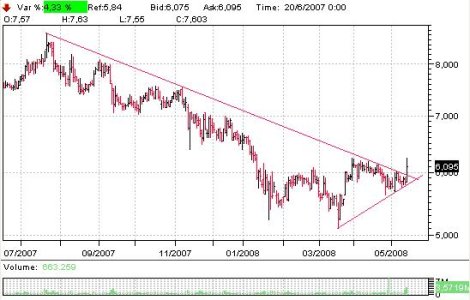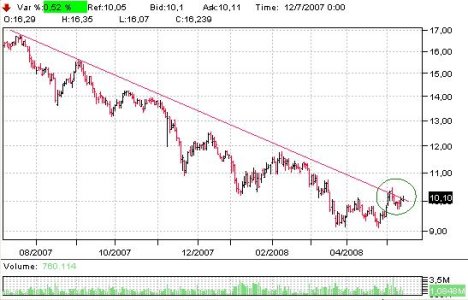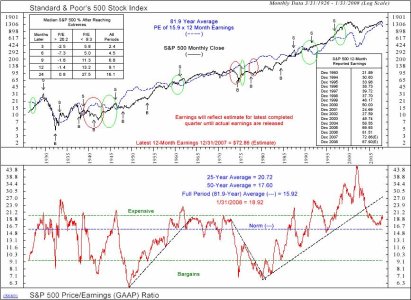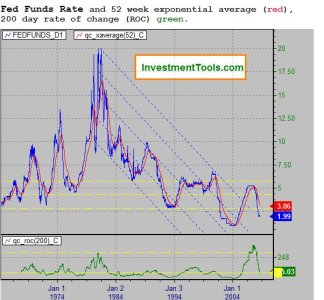Ne avevo parlato io.
Quì da noi siamo abituati a fare colazione a casa con la tazza di latte e i biscotti..ma negli states la colazione è un vero e proprio business con migliaia di americani che la fanno mentre vanno a lavoro (lo si vede anche nei vari film).
Per questo che l'affondo di Mac che entra decisamente nelle colazioni può creare qualche grattacapo a Starbucks...ora è attesa la mossa di Yum che per il momento non offre colazioni.
Mentre i vari Dunkin Brands sono in vendita se non erro... PG spinna tutto il settore caffè.
Ciao Extent !
STARBUCKS VS MAC DONALDS
While watching the coffee war take place, you should keep in mind that the value of a company is not all in the numbers.
Several years after the Civil War, Union General William Tecumseh Sherman was delivering a speech to a graduating class of cadets. When he finished his speech and was about to leave the podium, he turned toward the cadets and said, “I tell you, war is hell.” In no way can one compare the death and destruction of war with their counterparts in business, yet war and business have much in common. The book Market Warfare, by advertising and marketing gurus Al Ries and Jack Trout, outlines different strategies that companies take to win market share. The authors borrow liberally from On War, a book written by Prussian military strategist Carl von Clausewitz in the 1830s.
Warren Buffett, too, sees that the business world engages in warfare. He has compared the competitive landscape of business with the weapons technology of the Middle Ages, saying, “I don’t want an easy business for competitors. I want a business with a moat around it. I want a very valuable castle in the middle, and then I want a duke who is in charge of that castle to be very honest, hardworking, and able. Then I want a moat around that castle.”
For a business to succeed, it must have both a strategy and an enduring competitive advantage over its competitors. Most businesses fail in their first year, and only a small percentage are still around in five years, because they offer nothing to the marketplace that a competitor does not offer already. If a business does not have a competitive advantage or some type of “moat” around it, there is a very low chance that it will still be around in the years to come.
A Look Back
Do any of these companies–Midvale Steel & Ordnance, International Mercantile Marine, or Cambria Steel–ring a bell? I didn’t think so. Back in 1917, these three companies were considered among the best and strongest companies in the United States (ranked 8, 11, and 22 respectively by asset size). However, by 1923, Midvale Steel & Ordnance and Cambria Steel had been acquired, and International Mercantile Marine was dissolved in 1932. In fact, only 13 of today’s top 100 companies (ranked by asset size) were on the initial list in 1917.
The business environment has not gotten easier since 1917; in fact, it became a heck of a lot harder for a company to stay on top. Looking at the top 100 companies ranked by assets in 1985, a little more than two decades ago, is even more of a revelation, as what were then household names have now been knocked off their perch. Sears Roebuck, the second-ranked company in 1985, is ranked 63rd in 2007; the 28th-ranked Eastman Kodak and 39th-ranked Westinghouse Electric and Manufacturing didn’t even rank in the top 100 in 2007.
A company making the S&P 500 index list in the 1930s had a very good shot at staying on the list. On average, companies that made the index in the 1930s could expect to stay there approximately 65 years. The consulting firm McKinsey & Company estimates that by 2020, the average time a company will spend on the S&P 500 index will be only 10 years, due to attrition and mergers.
Staying power
There are several reasons why it is so hard for a company to stay on top. Many companies disappear simply because they were unable to change with the times, becoming dinosaurs in the face of rapid changes in technology. It appears that companies that constantly innovate and increase their “moats” are the ones to survive.
Recently, a competitor has been trying to breach the moat and attack the castle of a market leader. In the near future, I am quite confident that business students will be reading case studies on the battle between Starbucks and McDonald’s. This is a classic case of a castle with a wide moat coming under attack because the attacker believes it has caught the duke napping. Rather than get ahead of myself, let me give you a little background.
Commodity Becomes a Brand
In 1982, Starbucks had five retail stores and was selling coffee to restaurants in Seattle, Washington. It was during that year that Howard Schultz signed on to manage retail sales and marketing. After traveling to Italy, he convinced the owners of Starbucks to open a coffee bar. It was a huge success. He left Starbucks shortly after to start his own coffee bar and eventually acquired Starbucks’ retail operations for $4 million. One year after going public in 1992, Starbucks had 275 locations.
Today, Starbucks is the leading retailer and roaster of coffee in the world. There are nearly 7,000 Starbucks stores in the U.S. and almost 1,800 in international markets. In several zip codes in New York City, there is a Starbucks every 0.20 miles. Schultz’s genius is that he took a commodity (a cup of coffee), made it a brand, and was able to charge three times its market price. His vision was to make Starbucks serve as the “third place” people gather, between home and work.
The whole Starbucks experience–ordering the coffee, having the baristas prepare it in front of you, and then sitting down in an overstuffed chair to work on your laptop–is a competitive moat that has been difficult for competitors to breach. When comparing coffee retailers, there is Starbucks and there is…everyone else. For the past decade, Starbucks has grown by leaps and bounds. Other coffee retailers have tried to compete, such as Caribou Coffee and Peet’s Coffee & Tea, but they pale in comparison to Starbucks.
As the company’s expansion swept the U.S., Starbucks also began adding drive-through window service and selling breakfast sandwiches. By doing this, Starbucks encroached on another company’s territory, and it was only a matter of time before “war” would be declared.
Attack of the Clown
After going through several rough years, McDonald’s Corp. began turning things around. Now in the sixth year of this turnaround, the company is more responsive to its customers and to the marketplace and has become more profitable. Before attacking Starbucks head-on, McDonald’s scoped out the marketplace, saw what needed to be done, and then began executing.
In 2003, McDonald’s initiated a turnaround strategy called “Plan to Win.” The company slowly began remodeling its stores, moving from molded plastic booths and bright colors toward oversized chairs and softer lighting and colors, and even installed wireless Internet. In 2005, McDonald’s began taste testing its coffee and received positive feedback from people who sampled it. One year later, the coffee was changed to a stronger blend and marketed in McDonald’s stores as premium roast. And in February 2007, Consumer Reports magazine rated McDonald’s drip coffee as better testing than Starbucks’.
In a page out of Starbucks’ playbook, McDonald’s moved its espresso coffee machines to the front counter and added more “theater” to the process of ordering coffee. The company plans to roll out coffee bars with similar-tasting beverages, served by baristas, at lower prices, to its 14,000 U.S. stores in 2008.
Starbucks Slips
Starbucks’ moat had done a very good job of keeping competitors from attacking the castle. But over the past few years, Starbucks has slipped up just enough to allow McDonald’s to feel confident that it could take on this coffee giant. Starbucks was able to take a cup of coffee, dress it up with great atmosphere, and charge a much higher price than anyone had previously dared. But when the company installed drive-through windows, which now make up 80 percent of purchases, it lost the atmosphere premium. What was once a simple ordering process now became slower and more complex when breakfast and lunch sandwiches were added. Starbucks’ drive-in windows and breakfast sandwiches started to get that “fast food” feel.
Starbucks is not taking the McDonald’s threat lightly. Chairman Howard Schultz became more active, took the title of CEO, and already has made some changes. He wants to bring back the “romance” and “theater” that Starbucks once provided. In addition, Starbucks plans to reduce the number of promotions and items it offers and to focus on consistency of operations among all store employees. In other words, Starbucks is going back to basics and trying to turn specialty coffee from the commodity item it had become to the branded item it once was.
McDonald’s challenges
It is too early for McDonald’s to call its attack a victory. In fact, it may appear that this attack has awoken the slumbering giant. McDonald’s will need to get over several formidable hurdles before it becomes a more real threat. Because McDonald’s is a franchise system, it is optional for franchise owners to create coffee bars in their stores; most haven’t made the investment. Inconsistency is one area in which Starbucks has more control, since its stores are company-owned.
McDonald’s is going to find it hard to change the public’s perception of it from a kid-friendly fast-food restaurant to a third home for people between home and work. How successful will the company be in cross-selling a customer that just a dollar meal –a $3 latte?
Conclusion
While watching the coffee war take place, you should keep in mind that the value of a company is not all in the numbers. Every day in every industry, companies must be able to continue widening their moats and defending themselves or else their intrinsic value will eventually erode. Weaknesses are exploited, strategies are drawn up, and war is fought for territory–which, in business, is market share.
At the early stages of this conflict, I would wager that Starbucks has the advantage. Many great companies with strong brands–such as Coca-Cola, American Express, and even McDonald’s–have regrouped, got back to basics, and gone on to increase value for their shareholders.
Over the past year, Starbucks’ stock price has fallen nearly 50 percent. Mr. Market has priced in the worst-case scenario for Starbucks and is discounting its market dominance, competitive advantages, and strong brand. A stock price of $19 or less should provide investors with an adequate margin of safety. This is based on the assumption that Starbucks can grow earnings by 16 percent per year over the next five years (a drop of 36 percent from their past five-year average EPS of 25 percent) and trade at a P/E of 18. I have found the most profitable investments to be in buying a company with a wounded brand at a discount to its underlying value.
Buffett Talk to MBA Students at Florida University 1998
The Leuthold Group, “Are Google & Cisco Forever?…No Growth Is Permanent,” September 2007
Ibid.
 )
)


